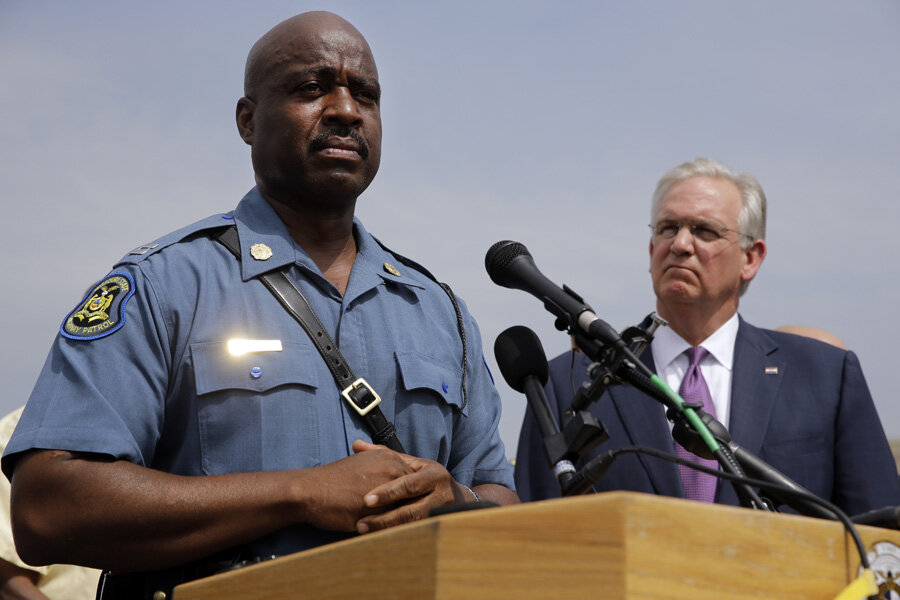In Ferguson, calm among protesters – but with an edge as police name shooter
Loading...
| Ferguson, Mo.
Walking away from where an unarmed black teenager was killed by a police officer last Saturday, Camese Bedford needed a break – some food and a shower – after waving a sign on West Florissant Avenue, where riots and looting have riveted America this week.
But the protester in Ferguson, Mo., says he’ll head back to the streets as dark beckons. Even though there are new developments in the case – including the naming of the police officer and a shake-up in police command to de-escalate protests – that isn’t enough, Mr. Bedford says, to tamp down the deep sense of injustice and conspiracy ringing in Ferguson after the death of Mike Brown.
“The only solution is for President Obama to come down here and restructure the police department, the political system, the schools,” says Bedford, a US Navy veteran. “White people here just hate black people, and they’ve kept us down for long enough. We’re not going to stop, because everything they say and do feeds the belief that there’s a conspiracy at work here.”
State Highway Patrol Capt. Ron Johnson, an African-American from the St. Louis suburbs, took control of security operations in Ferguson Thursday at the request of Missouri Gov. Jay Nixon (D). Then he marched with protesters.
"We're here to serve and protect," Captain Johnson said. "We're not here to instill fear.” But he also begged angry residents to remain peaceful. “This inner anger, we have to make sure we don’t burn down our own house,” he said.
Johnson’s tack was in stark contrast to violent, gas-stained standoffs that had marked the previous four nights since Mr. Brown was shot – images that stunned Americans and prompted some lawmakers to demand that police demilitarize their approach. After the change in command, protests Thursday night took on an almost festive tone with drinks and food, as well as handshakes, even hugs, for Johnson.
But that doesn’t mean everything is OK.
Jamel White, a Ferguson 18-year-old with braces, says he doesn’t steal “or anything like that” and stays out of the way of the police. He believes the riots and the looting, especially, have been ill-advised and are “another whole story, really,” from the Brown shooting.
At the same time, like most people here, he says, “I just want to know what happened, the full story.”
As protesters began to gather Friday on West Florissant Avenue – where liquor stores, hair braid shops, ice cream parlors, and shoe stores bear the plywood scars of looting – the report to the public by police about what happened to Brown may test Johnson’s strategy of de-escalation.
While naming Darren Wilson, a six-year veteran with no marks on his record, as the shooter, Ferguson Police Chief Thomas Jackson said Mr. Wilson was investigating a robbery in which Brown was a suspect. Police released a video that they say shows Brown stealing a box of expensive cigars and then shoving a clerk.
Johnson, speaking with both protesters and reporters on the streets Friday, noted the lack of consultation with him about the video release. There are others "who have committed a crime, and they're standing here today," he said.
Brown’s parents immediately called the information from the Ferguson police selective and an attempt at character assassination – on top of what many here believe was an actual assassination by a rogue police officer of an unarmed suspect who had put his hands up in surrender.
“The police are not being transparent, and they are strategically trying to justify this execution-style murder,” Benjamin Crump, a lawyer for the family, said.
The sense among many blacks here – that local police are protecting Wilson because he is a police officer – could again inflame passions on the streets, says Bedford, the Navy vet. While the local police department is nearly all white, the town is 70 percent black.
“Taking off riot gear means nothing,” he says. “We may get more violence.”
A USA Today study of FBI statistics showed that, of an average of 400 reported police shootings a year, 18 percent involved black teenagers and 9 percent involved white teenagers. Blacks make up 12 percent of the US population.
Although police have released more details of the Brown incident, their account differs from some others, and it’s still not clear why Brown was killed if his hands were up in surrender, as multiple eyewitnesses have testified.
Police say Brown struggled with Wilson, reaching for his gun. At least one shot went off in the squad car, police say, before Wilson fatally shot Brown.
Brown’s friend Dorian Johnson, who was with him on Saturday, said the officer grabbed Brown, tussled with him, then drew his gun and shot him. After an injured Brown ran, Mr. Johnson said, Wilson chased him and shot him several times after Brown put his arms up in surrender.
Police have decided not to release autopsy information that would show how many bullets Brown took and from which direction. They’re following Missouri protocol where officials usually hold onto autopsy reports until a toxicology test can be administered. That can take six weeks.






